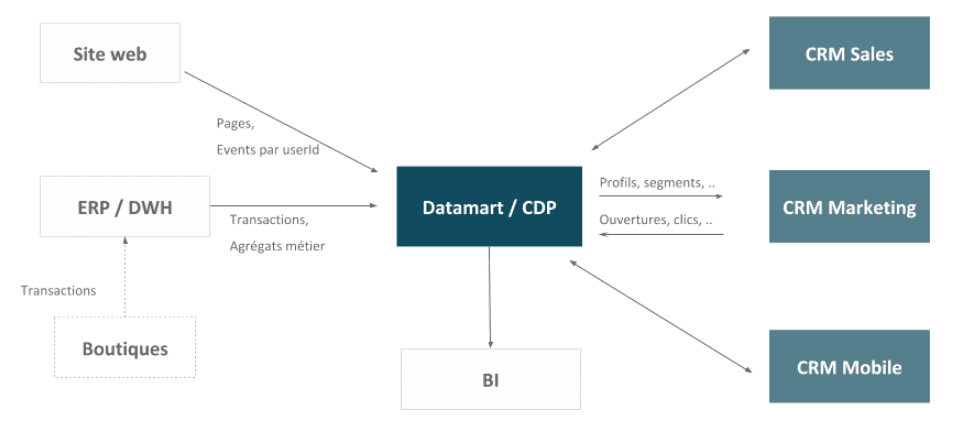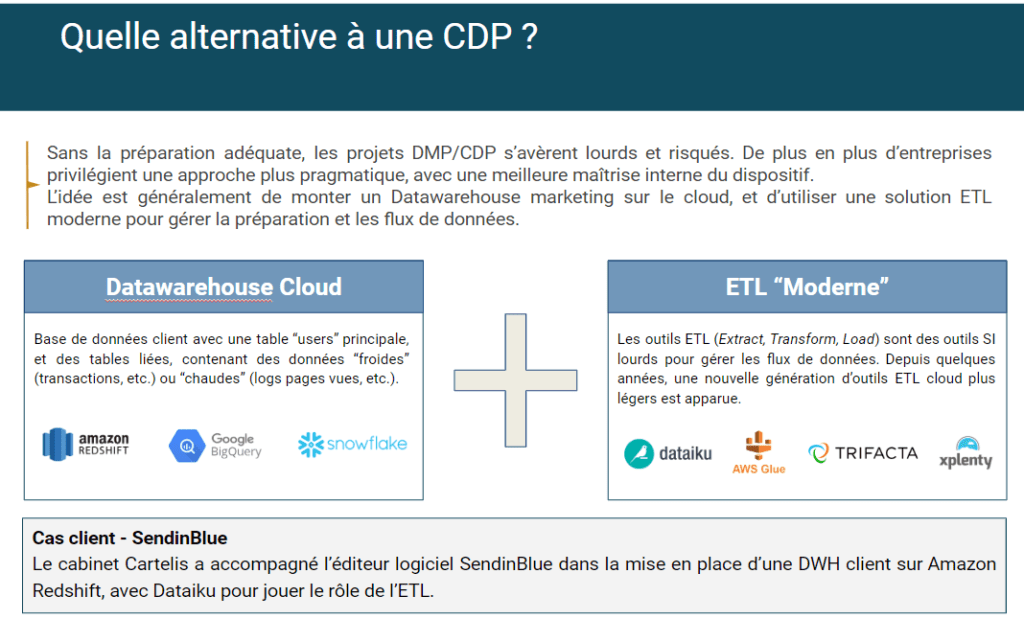At the origin of CDP, the evolution of CRM architectures
In the age of Big Data marketing, the modern CRM architecture is evolving. CRM software no longer necessarily plays the role of marketing database. Many companies are now choosing to distinguish between the marketing database on the one hand, and the activation and monitoring of the customer relationship on the other. The marketing database centralizes the customer data, it is the guarantor of the famous 360° customer view, and it is this marketing database that feeds the various marketing / CRM tools that need customer data. In many companies, we have a "commercial" CRM tool like Salesforce and a marketing CRM tool like Cabestan, Selligent or Adobe, and the marketing database is really the keystone of the system. Les bases de données marketing étaient jusqu’à présent très souvent des projets sur mesure, mais les choses sont en train de changer à pleine vitesse. L’émergence des Data Management Platforms (DMP) a participé à la structuration de ce marché en très forte croissance. Les annonceurs ont commencé à s’équiper de DMP dans l’objectif initial d’améliorer leurs performances media. Les DMP ont été de plus en plus utilisées comme bases de données marketing, ou comme base comportementale pour alimenter une base de données marketing complète, on parlait alors de “DMP customer centric” par opposition aux “DMP media”.
Ce sont les DMP customer centric which are now called Customer Data Platforms. The difference between DMP and CDP is not always clear, but you can remember:
Les bases de données marketing étaient jusqu’à présent très souvent des projets sur mesure, mais les choses sont en train de changer à pleine vitesse. L’émergence des Data Management Platforms (DMP) a participé à la structuration de ce marché en très forte croissance. Les annonceurs ont commencé à s’équiper de DMP dans l’objectif initial d’améliorer leurs performances media. Les DMP ont été de plus en plus utilisées comme bases de données marketing, ou comme base comportementale pour alimenter une base de données marketing complète, on parlait alors de “DMP customer centric” par opposition aux “DMP media”.
Ce sont les DMP customer centric which are now called Customer Data Platforms. The difference between DMP and CDP is not always clear, but you can remember:
- The CDP allows the storage and centralization of all the company's customer data for marketing and CRM purposes, while the DMP is mainly used for advertising retargeting purposes and is based on the use of anonymous data reconciled around cookies. Its operation consists in gathering web visitors into audience segments and transmitting these segments to media activation tools (DSP / SSP).
- CDPs are mainly based on First Party data, possibly enriched with Third Party data (web browsing behavior), whereas DMPs mainly use Third Party data to create anonymous audience segments.
Why set up a CDP or marketing database?
Many companies today choose to build a marketing database separate from their CRM. There are many reasons for this:- The activation of the customer relationship implies more and more different tools (chatbot, email automation, web personalization, ..) and all these tools need to be synchronized with a database that has to play the role of main repository.
- Marketing databases need to combine behavioral data (website visits, mobile application events, etc.) and transactional data. This implies a technological paradigm shift that CRM publishers are often still struggling to adapt to quickly.
- BI teams have data needs that are often similar to those of marketing teams, especially in terms of behavioral aggregates. Setting up a marketing database can help build a common database.

Need help?
Reading content isn't everything. The best way is to talk to us.
Leave a Reply